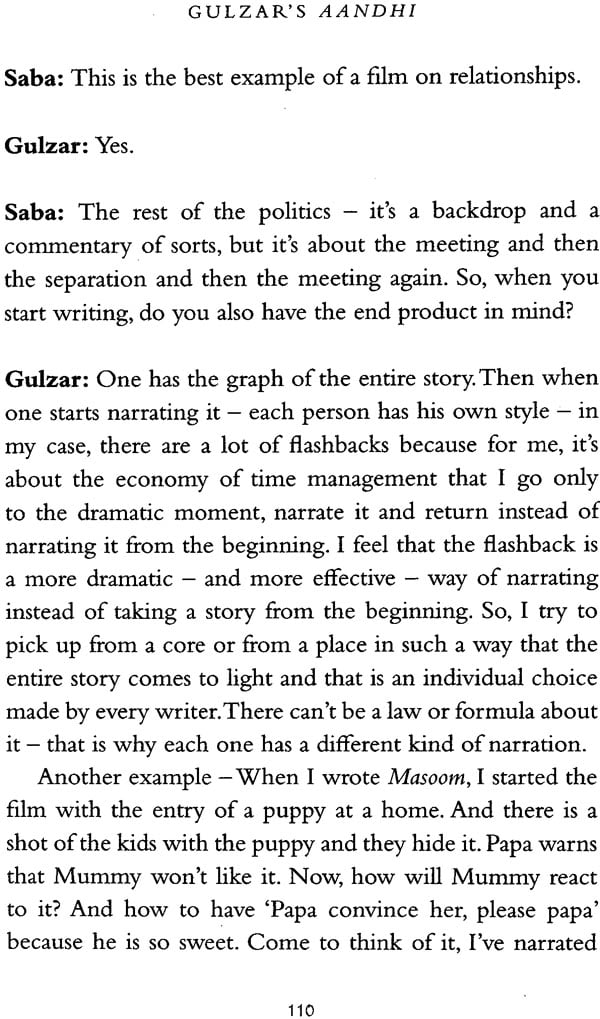
Gulzar's Aandhi
Book Specification
| Item Code: | NAQ593 |
| Author: | Saba Mahmood Bashir |
| Publisher: | Harper Collins Publishers |
| Language: | English |
| Edition: | 2019 |
| ISBN: | 9789353025083 |
| Pages: | 142 |
| Cover: | PAPERBACK |
| Other Details | 8.00 X 5.00 inch |
| Weight | 100 gm |
Book Description
At one level, Gulzar's Aandhi (1975) is a story of estranged love between two headstrong and individualistic personalities; at another, it is a tongue-in-cheek commentary on the political scenario of the country.
Through a close textual analysis of the film, this book examines in detail its stellar cast, the language and dialogues, and the evergreen songs which had a major role in making the film a commercial success.
Gulzar's own insights into the making of Aandhi (from an interview) will further enhance the readers' understanding of the film.
Saba Mahmood Bashir's book will delight those wanting to savour the duality and drama that befit life, or shall we say, cinema.
About the Author
SABA MAHMOOD BASHIR is a poet, author and a translator. Her first book was a collection of poems, Memory Past (2006) brought out by Writers' Workshop. She has also authored I Swallowed the Moon: The Poetry of Gulzar (HarperCollins India, 2013) and translated Gulzar's screenplays of Premchand's Godaan and Nirmala and Other Stories. Her forthcoming book is a translation of selected short stories by Manto.
Cinema in India, as elsewhere too, is one of the most crucial parameters to gauge the changing shifts in society - at political, sociocultural and even economic levels. A film is not created in a vacuum. It has its own distinct space, roots and character.
At the outset, I wish to declare that I believe in looking at Hindustani cinema based on Indian parameters. Cinema in India is a genre in itself. One should not look at and analyse it on parameters made commonplace by the West. The Western definitions of the words 'musical' and 'melodrama' are not applicable to Indian cinema. In the same way, the idea of a `multi-starref or a 'devotional' film might sound alien in world cinema.
When a film is made for Indian audiences, it needs to be evaluated and understood from their perspective. The perspective of looking at a film should depend on the origins and circumstances of its viewers. I am not sure if I subscribe to Paul Willemen's Vinephilia', the theory which suffers from considerable neglect in film theory' Instead I consciously attempt to look at Indian films through a certain innate Indian-ness.
That said, I have translated Gulzar's Aandhi on self-established paradigms. An attempt has been made to look at the structure of the film, by being cognizant of the fact that the story is set against the turbulent political backdrop of elections and politicking between various political parties and its leaders. The analysis of the cinematic text led to the exploration of the visual, narrative and self-reflexive elements of the film. This book further explores the very essence of the film: the love story between a hotel manager (JK), and his ambitious wife (Aarti), who aspires to be a minister one day. A close textual analysis has been adopted to view the film and delve into its layers.
Sumita S. Chakravarty2 points out that the Hindi-Urdu word for a film screen is 'purdah', or curtain - that which hides rather than reveals. Popular Indian conception of the cinema, therefore, associates film with the invisible rather than the visible. Building on this premise, one can unravel the ambiguity apparent in a film.
I am also wary of the generic classification of films into 'art' cinema and 'popular' cinema. These parameters have been created by different theorists and critics. However, most films cannot fall in such distinct categories. What are the base parameters that put the films in tight compartments? Would a film be 'art' if it depicted the harsh reality of a country? If it featured a romance-driven plot with song and dance sequences, would it be 'commercial' cinema? It doesn't stop there. There are various categories in commercial cinema as well - mythological, historical, action, romantic-comedy, etc. Also, there are Indian commercial films which do well overseas, and have an international presence. What about films like Pyaasa (1957), Mother India (1957) and Mughal-e-Azam (1960) - to name only a few - where the so-called boundaries between art and commercial cinema clearly seem to have blurred and merged? Aandhi is one such film. It was a commercial success - featuring a strong, memorable love story, which was also a tongue-in-cheek comment on the then political scenario of the country.
This book is divided into five chapters. It begins by looking at its filmmaker, Gulzar, and how Aandhi is a director's film, all the way. The first chapter also
Book's Contents and Sample Pages










